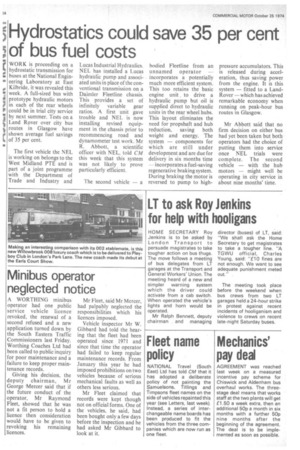Hydrostatics could save 35 per cent of bus fuel costs
Page 26

If you've noticed an error in this article please click here to report it so we can fix it.
WORK is proceeding on a hydrostatic transmission for buses at the National Engineering Laboratory at East KiIhride, it was revealed this week. A full-sized bus with prototype hydraulic motors in each of the rear wheels could be in trial city service by next summer. Tests on a Land Rover over city bus routes in Glasgow have shown average fuel savings of 35 per cent.
The first vehicle the NEL is working on belongs to the West Midland PTE and is part of a joint programme with the Department of Trade and Industry and Lucas Industrial Hydraulics. NEL has installed a Lucas hydraulic pump and associated units in place of the conventional transmission on a Daimler Fleetline chassis. This provides a set of infinitely variable gear ratios. A first unit gave trouble and NEL is now installing revised equipment in the chassis prior to recommencing road and dynamometer test work. Mr R, Abbott, a scientific officer with NEL. told CM this week that this system was not likely to prove particularly efficient. bodied Fleetline from an unnamed operator incorporates a potentially much more efficient system. This too retains the basic engine unit, to drive a hydraulic pump but oil is supplied direct to hydraulic units in the rear wheel hubs. This layout eliminates the need for propshaft and hub reduction, saving both weight and energy. The system — components for which are still under development and are due for delivery in six months time — incorporates a fuel-saving regenerative braking system. During braking the motor is reversed to pump to high pressure accumulators. This is released during acceleration, thus saving power from the engine. It is this system — fitted to a LandRover — which has achieved remarkable economy when running on peak-hour bus routes in Glasgow.
Mr Abbott said that no firm decision on either bus had yet been taken but both operators had the choice of putting them into service once NEL trials were complete. The second vehicle — with the hub motors — might well be operating in city service in about nine months' time.












































































































































